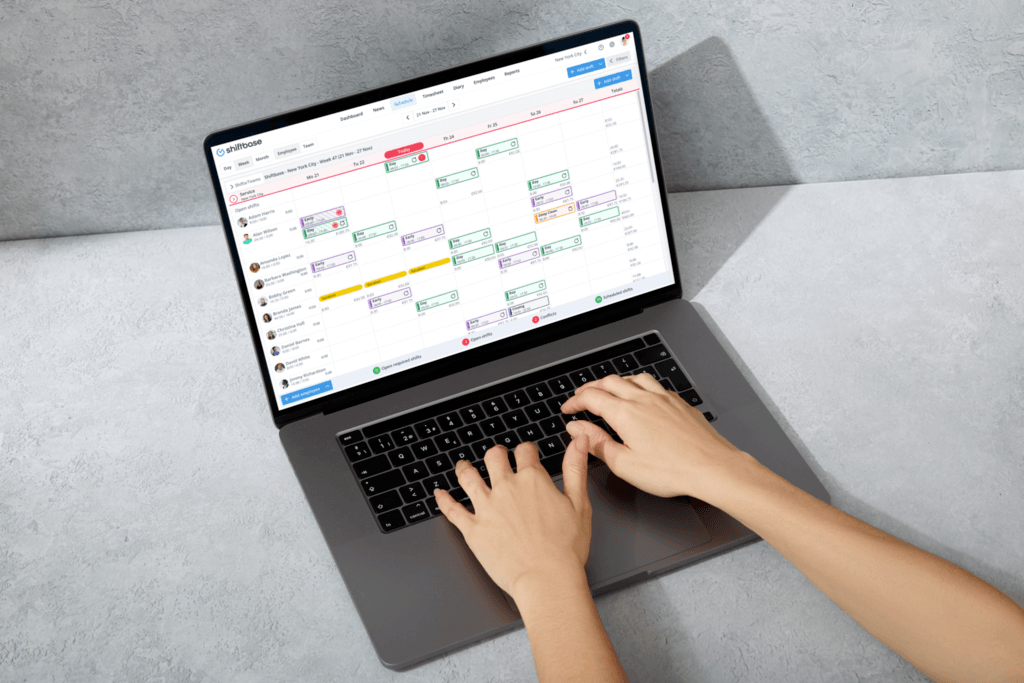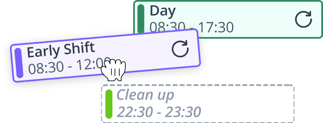This article will explore the concept of labor tracking, its importance for businesses, key components of an effective labor tracking system, and best practices for implementing it in your organization.
What is labor tracking?
Labour tracking is the process of monitoring and recording how employees spend their working hours. It helps employers understand where time is being spent, how resources are used, and whether productivity goals are being met.
Why it matters
Tracking labour accurately can:
- Improve workforce planning and shift scheduling
- Prevent time theft and buddy punching
- Help with payroll accuracy and compliance
- Identify areas where productivity can improve
- Ensure you're meeting legal working hour limits
Common labour tracking methods
|
Method |
Description |
Best suited for |
|---|---|---|
| Manual timesheets | Paper or spreadsheet-based logging of hours | Small teams or businesses with low complexity |
| Punch clocks or timecards | Employees punch in/out using a physical or digital clock | Manufacturing or retail |
| Mobile time tracking apps | Employees track time via smartphone or tablet, often with GPS | Field services, construction, remote teams |
| Biometric time clocks | Use of fingerprint or facial recognition to log hours | Medium to large businesses needing extra security |
| Workforce management software | All-in-one tools that track time, automate schedules, and manage compliance | Businesses looking to streamline operations |
A quick example: Imagine you're running a cleaning company. With proper labour tracking, you can see:
- Which cleaner is assigned to each location
- How long each job takes
- If someone is consistently finishing early or overrunning
This insight helps you make better decisions—whether that’s adjusting staffing levels or billing clients more accurately.
💡Useful Read: What’s The ROI of Rota Software? Savings, Benchmarks & Calculator
Key components of an effective labor tracking software
Not all labour tracking tools are created equal. A good system goes beyond just clocking in and out—it gives HR managers and employers the insight and control needed to manage time, compliance, and productivity effectively.
Below are the essential features you should look for in modern labour tracking software:
✅ Accurate time tracking
At its core, the software should reliably track when employees start, take breaks, and finish work.
- Multiple clock-in options: mobile app, desktop, biometric, or kiosk
- Real-time updates for managers to monitor who’s currently working
- Automatic calculation of total hours worked (including overtime)
Useful Read: How to Create a Clocking In and Out Policy That Works + Free Template
✅ Geolocation and geofencing
Especially useful for remote or mobile teams, these features allow you to:
- Track where employees clock in from
- Set specific zones where time tracking is allowed (geofencing)
- Reduce time fraud and unauthorised clock-ins
💡Example: A construction worker can only start tracking time when they’re within the job site’s GPS range.
✅ Automated scheduling integration
Time tracking works best when it connects with your shift planning. Look for:
- Drag-and-drop schedule creation
- Automatic updates to time logs when shifts change
- Notifications for shift start/end, overtime, or missed punches
This makes life easier for both HR and team leaders, while reducing scheduling conflicts.
✅ Compliance and legal safeguards
Labour laws can be complex and change from one region to another. A reliable tool helps you stay compliant by:
- Flagging when employees approach legal work hour limits
- Keeping detailed records for audits or legal disputes
- Managing rest breaks and meal periods properly
👉Example: Alerts for exceeding 48-hour weekly work limits (UK) or daily overtime thresholds (US/Canada).
✅ Payroll integration
Manual payroll calculations? No thanks.
Effective systems should:
- Sync time logs directly with payroll systems
- Handle rounding rules, pay rates, and different contract types
- Cut down payroll processing time significantly
✅ Customisable reporting and dashboards
You need clear data to make smart decisions. Reporting features should offer:
- Daily, weekly, or monthly overviews of hours worked
- Cost reports per project, location, or department
- Exportable reports (PDF, Excel, CSV) for payroll or leadership
📊 Example table view:
|
Employee |
Total Hours (Week) |
Overtime |
Location |
Labour Cost (£) |
|---|---|---|---|---|
| John Smith | 42 | 2 | London Store | £560 |
| Lisa Walker | 38 | 0 | London Store | £475 |
✅ User-friendly interface
It might sound basic, but usability is key.
- Easy for employees to clock in/out without confusion
- Simple for admins to review, adjust, and approve hours
- Works well on mobile and desktop
The smoother it is to use, the more likely your team will actually use it correctly.
What labour tracking method is right for your business?
Choosing the right way to track labour isn’t about what’s popular—it’s about what fits your team, your industry, and your day-to-day operations.
Here’s a breakdown of the most common methods, when they work best, and their pros and cons:
1. Manual timesheets
- How it works: Employees record hours worked on paper or a spreadsheet.
- Best for: Small businesses with just a few employees or low-tech needs.
|
✅ Pros |
❌ Cons |
|---|---|
| Low cost | Prone to human error |
| Easy to set up | Easy to manipulate or falsify |
| No training needed | Time-consuming for payroll |
Useful Read: Excel + WhatsApp vs Shiftbase: The True Cost of Rotas, Time Edits and Payroll Errors
2. Punch clocks or timecards
- How it works: Physical or digital punch-in/out system on-site.
- Best for: Manufacturing, warehouses, or hospitality businesses.
|
✅ Pros |
❌ Cons |
|---|---|
| Simple to use | Not ideal for remote workers |
| Good for clocking shift times | Requires hardware or setup |
| Often integrates with payroll | Maintenance and potential errors |
3. Mobile time tracking apps
- How it works: Employees clock in/out using a smartphone or tablet; often with GPS or geofencing.
- Best for: Remote teams, field services, construction.
|
✅ Pros |
❌ Cons |
|---|---|
| Ideal for mobile workforces | May raise privacy concerns |
| Geolocation adds accuracy | Requires internet or mobile data |
| Paperless and real-time logs | Tech training may be needed |
4. Biometric systems
- How it works: Clock-ins via fingerprint or facial recognition.
- Best for: Medium to large businesses needing security and precision.
|
✅ Pros |
❌ Cons |
|---|---|
| High accuracy | Can be expensive to implement |
| Prevents buddy punching | GDPR/data protection concerns |
| Speeds up shift transitions | May not suit all industries |
5. Workforce management software (WFM)
- How it works: All-in-one system combining time tracking, scheduling, reporting, and compliance.
- Best for: Growing or multi-location businesses aiming to streamline HR operations.
|
✅ Pros |
❌ Cons |
|---|---|
| Everything in one place | Higher upfront cost (but saves time) |
| Great for compliance | Needs onboarding and setup |
| Scales with your team | Can be feature-heavy for small teams |
How to choose
Ask yourself:
- Are your workers remote, in-office, or both?
- Do you need detailed reports and legal compliance tools?
- How often do you process payroll?
- Are time theft or buddy punching real concerns?
If you’re managing more than 10 employees or juggling shifts across locations, a dedicated labour tracking or WFM software is often worth the investment.
🔍 Tip: Start with a free trial to test usability before committing.
Best practices for labor tracking

Implementing best practices ensures that labor tracking systems are efficient and effective.
Regular reviews and audits
Conducting regular reviews and audits of labor tracking data is crucial for maintaining accuracy and efficiency. Regular audits help identify discrepancies, ensure compliance with labor laws, and improve overall data quality. By reviewing the data frequently, managers can make informed decisions that enhance productivity and resource allocation.
Integrating with payroll and HR systems
Integrating labor tracking with payroll and HR management systems offers several benefits. It streamlines processes, reduces administrative work, and ensures accurate payment of wages. This integration allows for seamless data flow between systems, improving overall efficiency and reducing the risk of errors. By having a unified system, managers can better manage shifts, attendance, and employee performance.
Continuous improvement
Implementing a continuous improvement approach to labor tracking practices is essential for long-term success. This involves regularly updating the labor management system based on feedback and technological advancements. Encouraging a culture of continuous improvement helps in adapting to changing needs and improving the overall effectiveness of the labor tracking process.
Why Shiftbase is the perfect labor tracking tool
If you're tired of juggling spreadsheets, chasing timesheets, or second-guessing your labour costs, it might be time to switch to something smarter. Shiftbase is an all-in-one workforce management platform built to help businesses track time, plan shifts, and stay compliant—with less admin and more control.
With Shiftbase, time tracking is precise and flexible. Employees can clock in and out using a mobile app, tablet, or desktop. For field teams, features like GPS tracking and geofencing ensure that hours are logged only from authorised locations—cutting down on time theft and boosting accountability.
Shift planning is just as seamless. The intuitive drag-and-drop scheduler lets you assign shifts based on availability, location, or role. If changes come up, employees receive real-time notifications—so no more last-minute no-shows or rota confusion.
What truly sets Shiftbase apart is its ability to turn time data into actionable insights. You’ll have access to dashboards that show:
- Real-time labour costs across teams or locations
- Overtime and absenteeism trends
- Exportable reports for payroll or audits
No more guesswork—just clear, data-driven decisions.
And when it comes to compliance, Shiftbase has you covered. It automatically tracks working time regulations, ensures break rules are followed, and stores digital records that make audits simple. Whether you need to stay within the 48-hour working limit or pay the right rate for every hour, you’ll have the tools to do it right.
Best of all, Shiftbase grows with your business. It’s user-friendly, multilingual, and works just as well for 5 employees as it does for 500. Whether you’re managing a single location or multiple branches, Shiftbase gives you a clear, central view of your entire workforce.
🎯 Curious to see how it works?
👉 Start your 14-day free trial – no credit card required.

- Easily clock in and out
- Automatic calculation of surcharges
- Link with payroll administration


